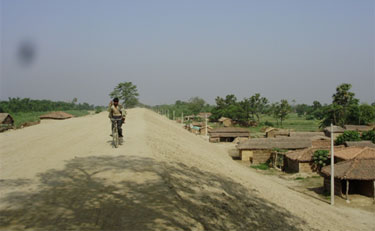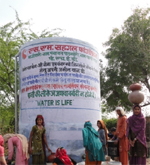/topics/governance
Governance
Women at the center of climate friendly approaches to agriculture and water use - A report by the Institute for Agriculture and Trade Policy
Posted on 17 Jun, 2011 10:45 AM The Institute for Agriculture and Trade Policy draws on the experiences of the Tamilnadu Women’s Collective (WC), a state-level federation of women’s groups from 1,500 villages, in the context where communities all around the world are struggling to find ways to cope with changes affecting food and water security because of the phenomenon of climate change.
The report argues that many a times, new food and water security policies at the national and international level tend to be narrow, look at each of these issues in isolation and undermine food and water security strategies adopted by individuals and households from marginal groups. Adaptation strategies to address food security focus almost exclusively on increasing agricultural production, while ignoring health and cultural aspects of the food being produced, and the role of agriculture as a means for rural viability.
Accelerated programmes - What can the water sector learn from the power sector? – An article in EPW by Tushaar Shah
Posted on 16 Jun, 2011 09:11 PMThe Government of India’s 15-year old AIBP has come under much-deserved criticism for all-round non-performance. It was introduced to support states in "last mile" public irrigation projects, that is, projects which are nearly completed but whose full benefits can start flowing only after small, incremental investments are made. Yet, the AIBP has been used mostly for funding new projects.
Independent water regulatory authorities in India - Analysis and interventions - A compendium of analytical work by PRAYAS
Posted on 16 Jun, 2011 08:09 PMThese reforms have led to the establishment of Independent Regulatory Authorities (IRAs) in the water sector through the enactment of laws at the state level.
MoEF signs three agreements with World Bank for cleaning Ganga and conservation of biodiversity in June 2011
Posted on 16 Jun, 2011 04:55 PMThe River cleaning project is to the tune of US $ 1 billion (approximately Rs 4,600 crore) loan and credit that will form part of the Bank’s long-term support for cleaning the Ganga River. Two Biodiversity Conservation agreements are for a credit of US$15.6 million and US$8.14 million grant.
On this occasion, Sh Jairam Ramesh , Minister of State for Environment and Forest Minister said, “Two protected areas, one each in Uttarakhand and Gujarat, will put in place a complete new model of managing the protected areas while safeguarding the livelihoods of local communities. So far local community was looked as enemies of protected areas, but this has to be changed. We have to make local communities full partners in the protection and regeneration of these protected areas. These new models will be applied in other areas of the country.” Giving details of cleaning operations of last few years, the Minister said, “The objective of Ganga project is ‘by 2020 no municipal sewage and industrial effluent will be let into the river Ganga without treatment’. With the help from the World bank, we are taking a big step forward in achieving the Mission Clean Ganga”.
Villages in north Bihar sinking in Bagmati's sand - Entire flood control planning needs thorough review - Article by Dinesh Kumar Mishra in d-sector.org
Posted on 16 Jun, 2011 03:56 PM The Bagmati Embankment separating riverside on the left and countryside of the right near Ibrahimpur – Electric poles suggest the height of the embankment
The Bagmati Embankment separating riverside on the left and countryside of the right near Ibrahimpur – Electric poles suggest the height of the embankment
One often hears about the civilizations buried under earth and attributes various reasons for such disappearance of life from a particular place. Excavations reveal the way of life the people might have had before they chose to leave their villages and towns and allowed the nature to take its own course. These accounts are available in books and we all believe the process told to us by historians and archaeologists. These are all conjectures that are revealed by scientific investigations but how many of us have seen, not read, how the civilizations get buried under the debris created by nature? There are places in Bihar where one can see the process of disappearance of civilization and the villages getting buried under the sediments brought by rivers.
Nominations invited for Times of India 'Social Impact Awards' in livelihood
Posted on 16 Jun, 2011 01:42 PMThe Times of India Social Impact Awards in partnership with J.P.Morgan is a platform wherein applications and nominations for Awards can be made by NGO’s, corporates and government organizations under five categories (Health, Education, Environment, Livelihood, and Empowerment & Advocacy).
Pravah calls for SMILE internship 2011
Posted on 15 Jun, 2011 05:45 PM Pravah is an organization based in New Delhi that works with young people to impact issues of social justice through youth citizenship action.
Pravah is an organization based in New Delhi that works with young people to impact issues of social justice through youth citizenship action.
SMILE internship gives you an opportunity to explore your self as you experience life in a community, learn about the joys and struggles of the people, discover the treads that bind you and them, and understand your society better.
Nominations invited for Times of India 'Social Impact Awards' on environment
Posted on 15 Jun, 2011 05:31 PMThe Times of India Social Impact Awards in partnership with J.P.Morgan is a platform wherein applications and nominations for Awards can be made by NGO’s, corporates and government organizations under five categories (Health, Education, Environment, Livelihood, and Empowerment & Advocacy).
Of soils, subsidies and survival - A report on living soils by Greenpeace India
Posted on 15 Jun, 2011 09:54 AMSoil is one of the basic natural resources that supports life on Earth. It is an ecosystem, which is a home to several living organisms, which make the soil alive and give it a good structure and texture.
A living soil ecosystem nurtures and nourishes plants by providing a healthy medium to take roots through a steady supply of nutrients. Use of chemical fertilisers disturbs the natural soil ecosystem and its indiscriminate use has resulted in the degradation of soil. A total neglect of ecological/organic fertilisation by policy makers, extension officers and farmers during the peak Green Revolution period has also added to the soil health crisis.
This report pools together scientific literature as well as farmers’ views on this issues as many a times, while studying issues related to soil health or while making policies related to it, the farmer, who is the most important stakeholder, is seldom consulted. The report has made an effort to rectify this grave inadequacy by including the farmer's perspectives in the academic processes like the social surveys, public hearings and workshops and in this final report. Every section of the report has a component from the existing scientific literature available and another one on the farmers’ opinion on the same area.
Patkhori's water solutions - A case study from the work of SM Sehgal Foundation in Mewat, Haryana
Posted on 14 Jun, 2011 05:27 PM Community water tank
Community water tank





